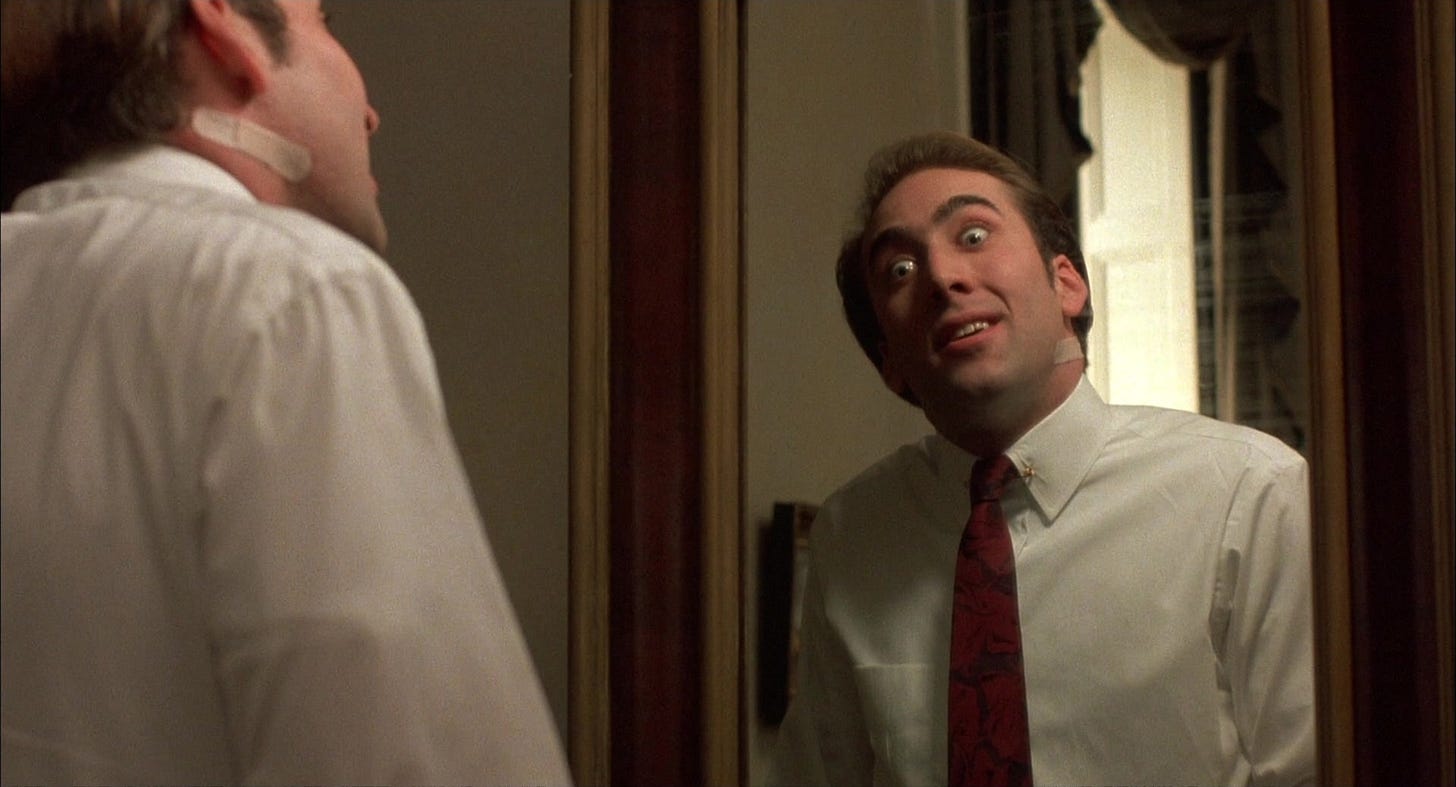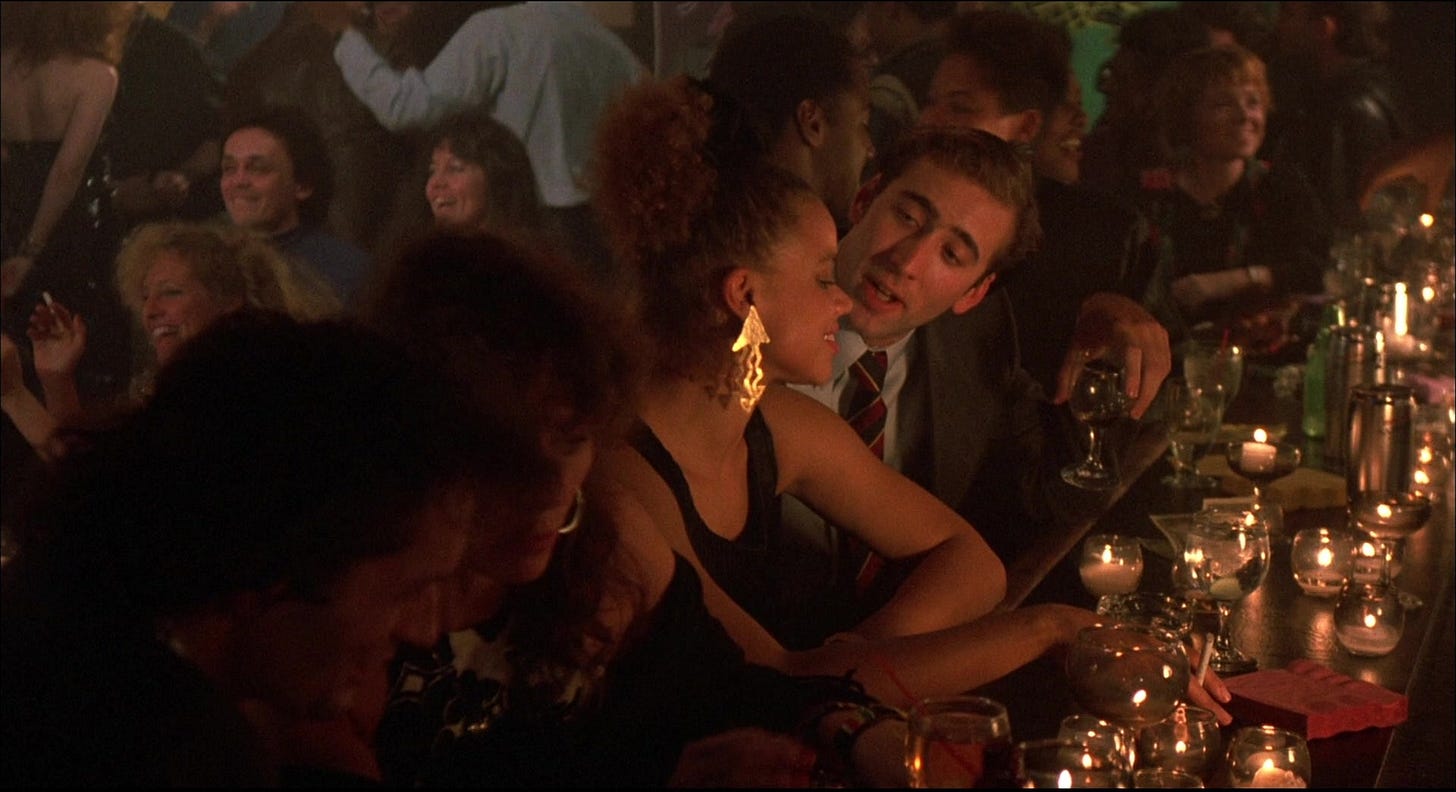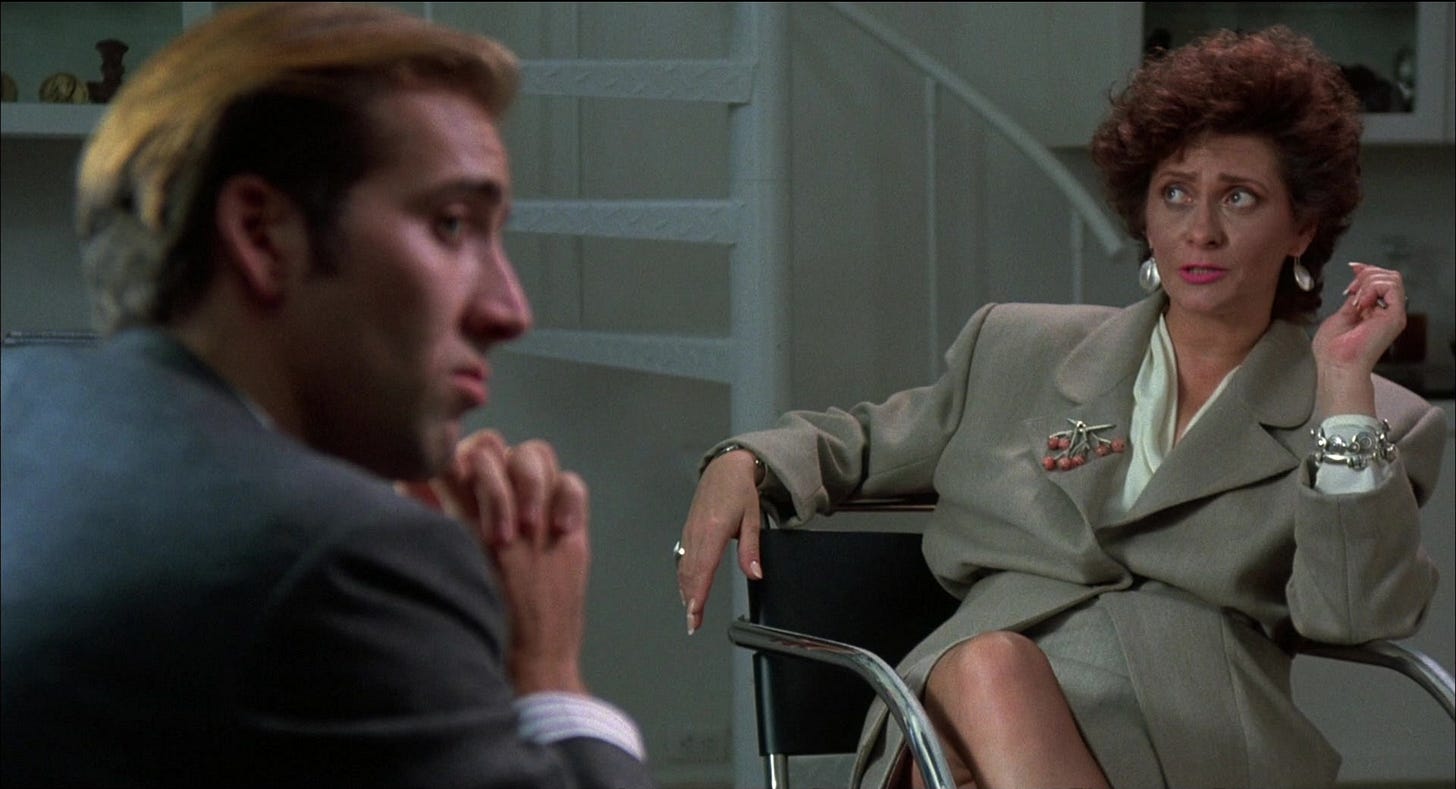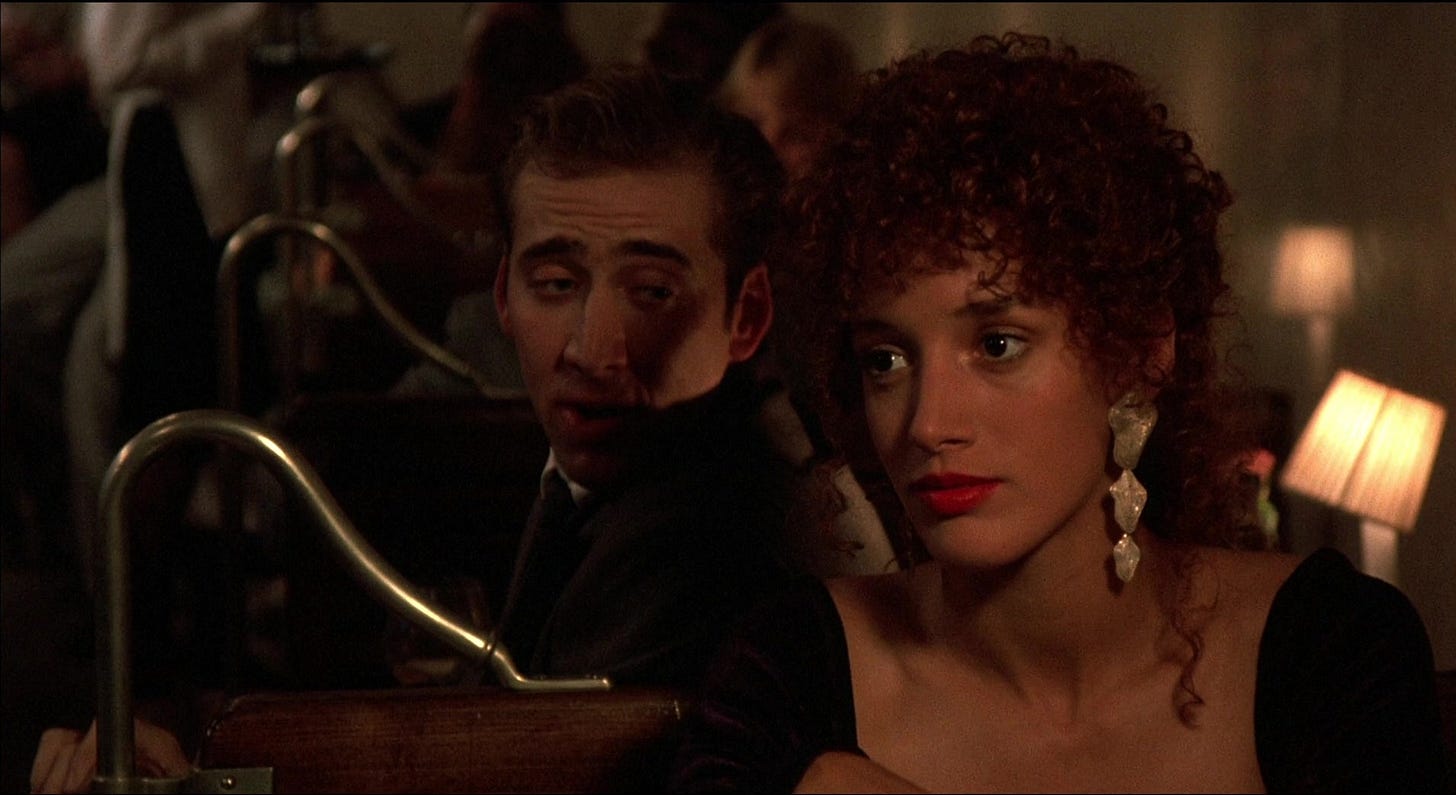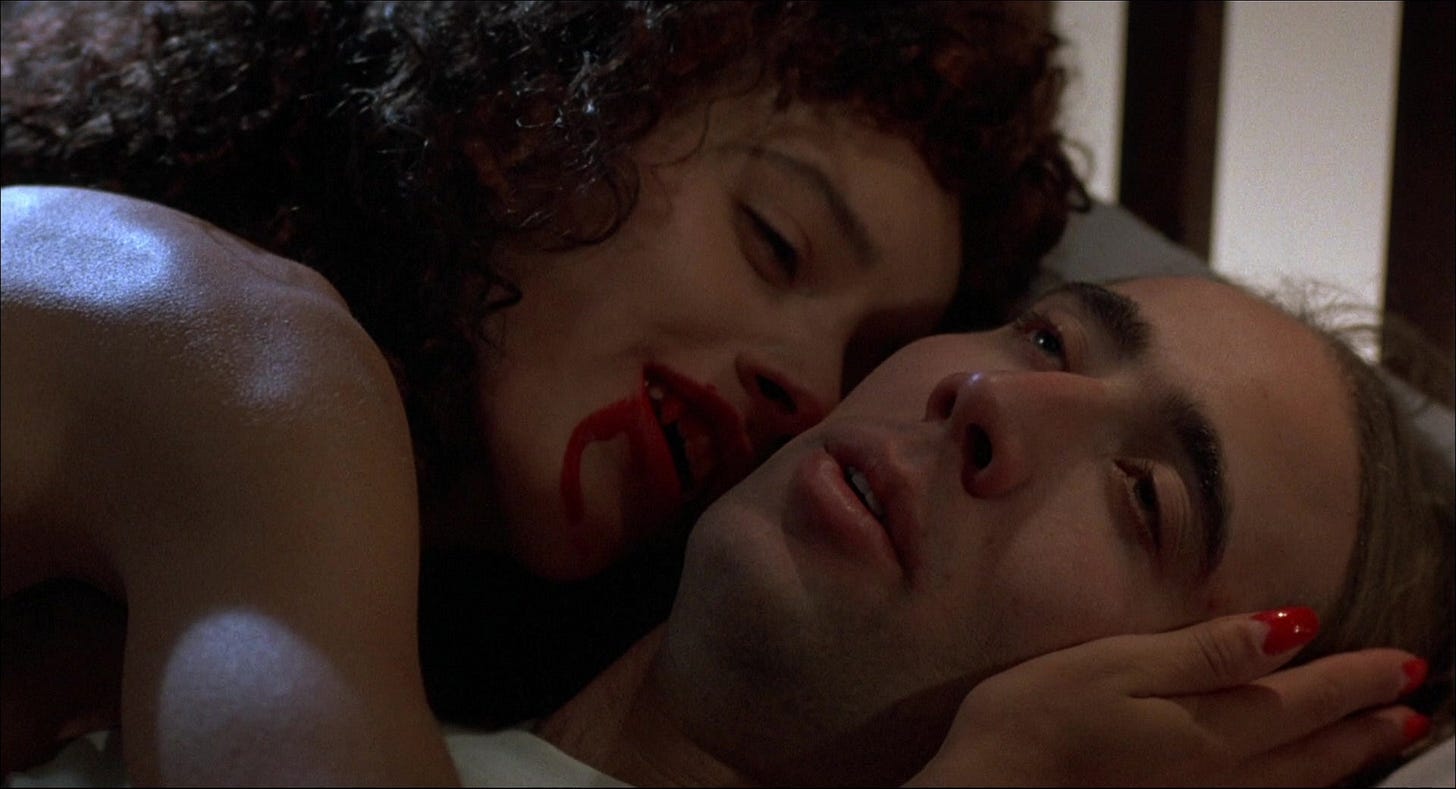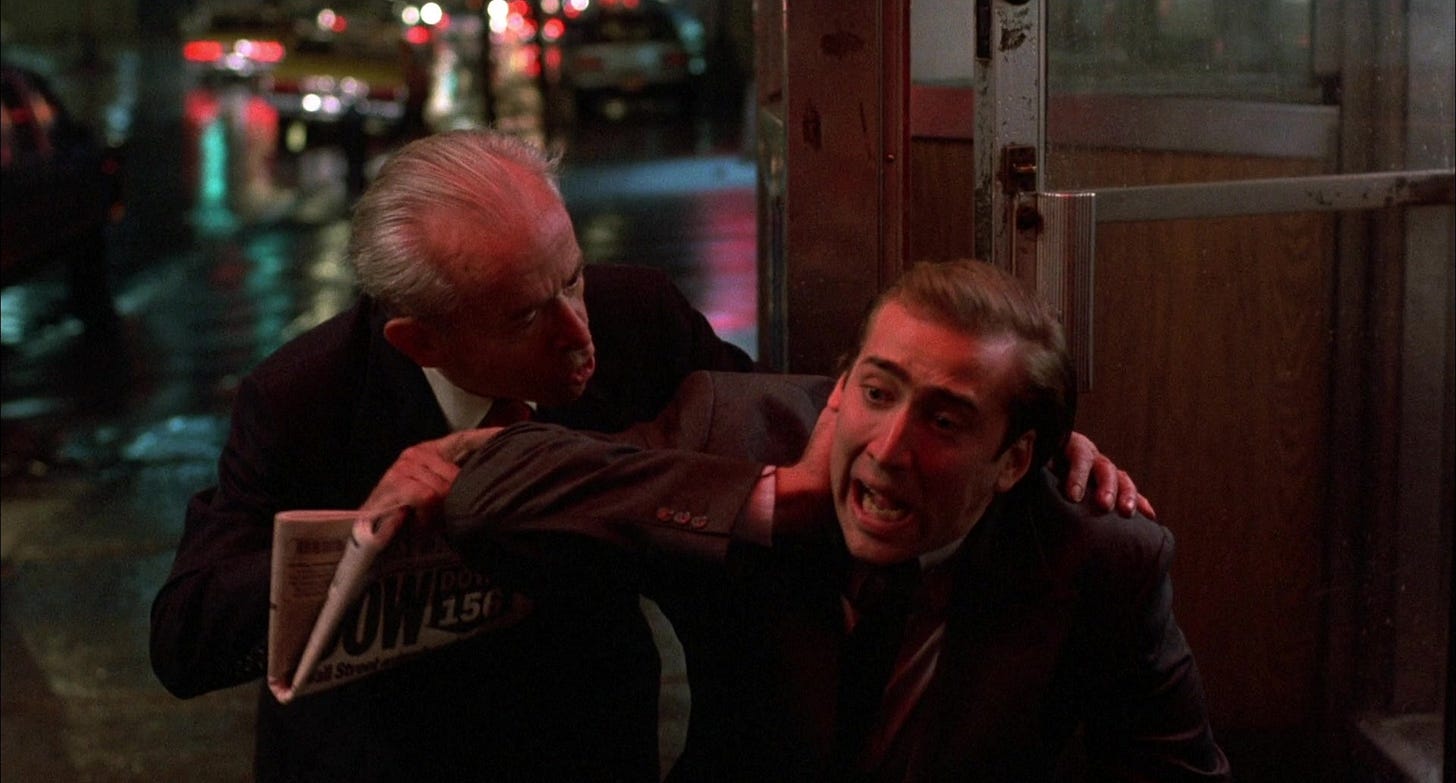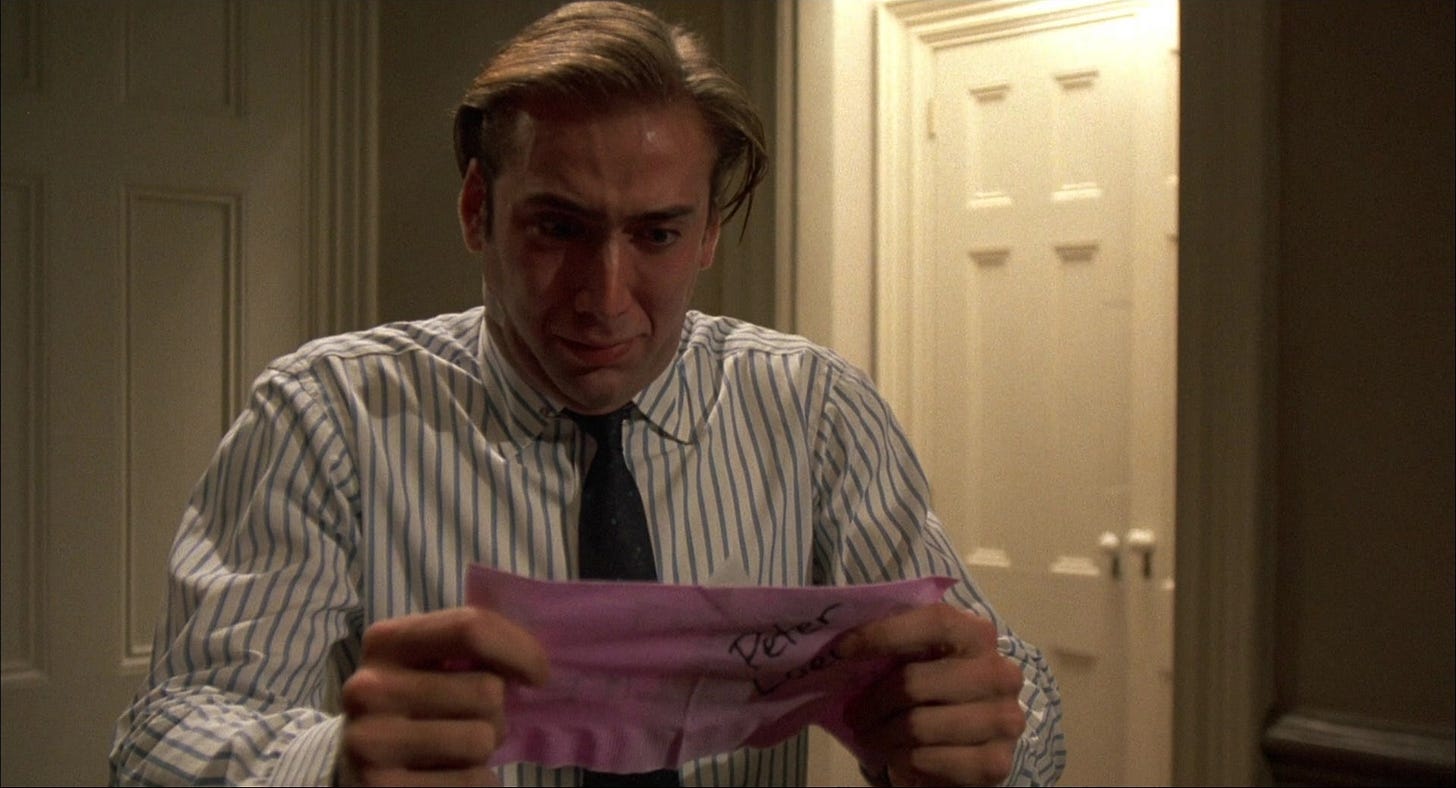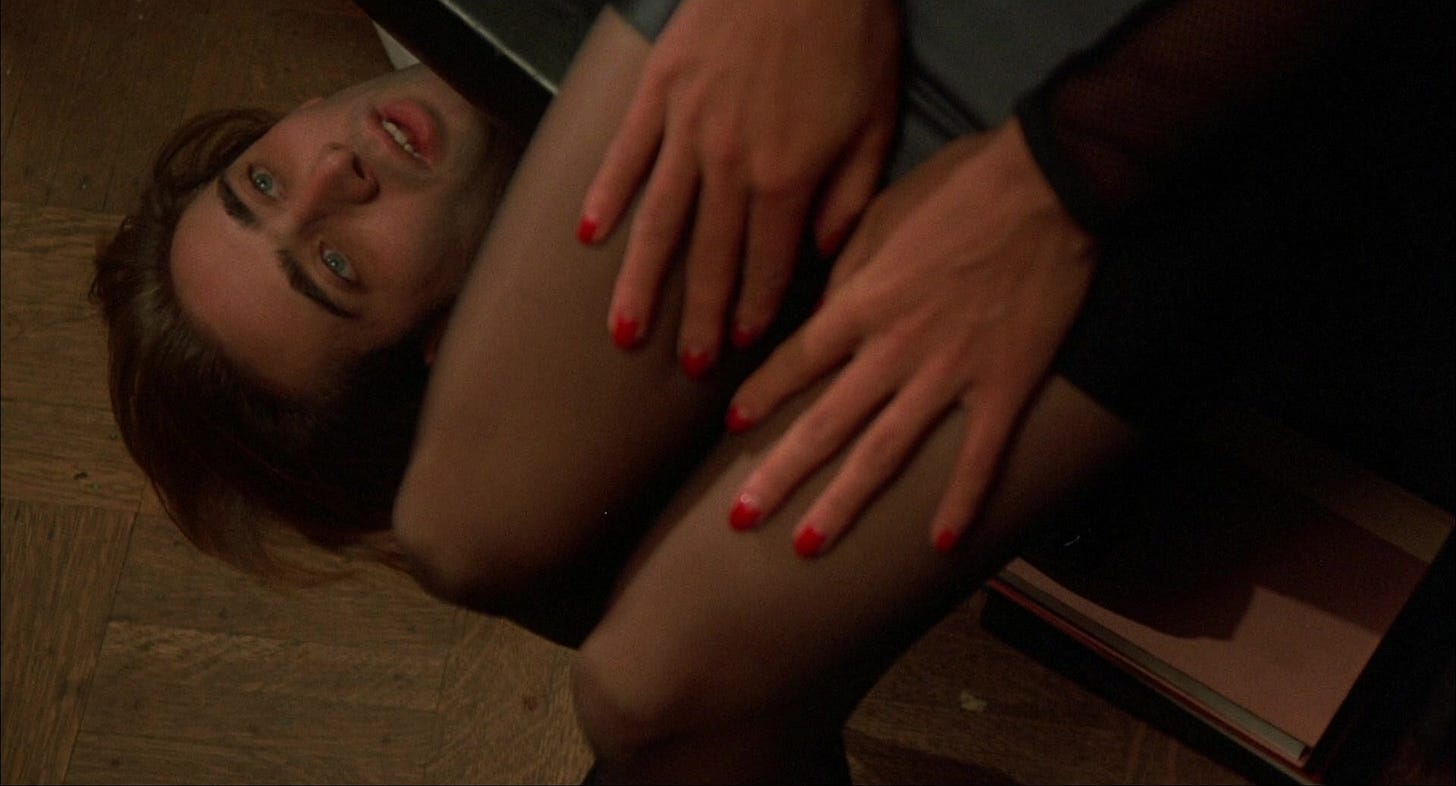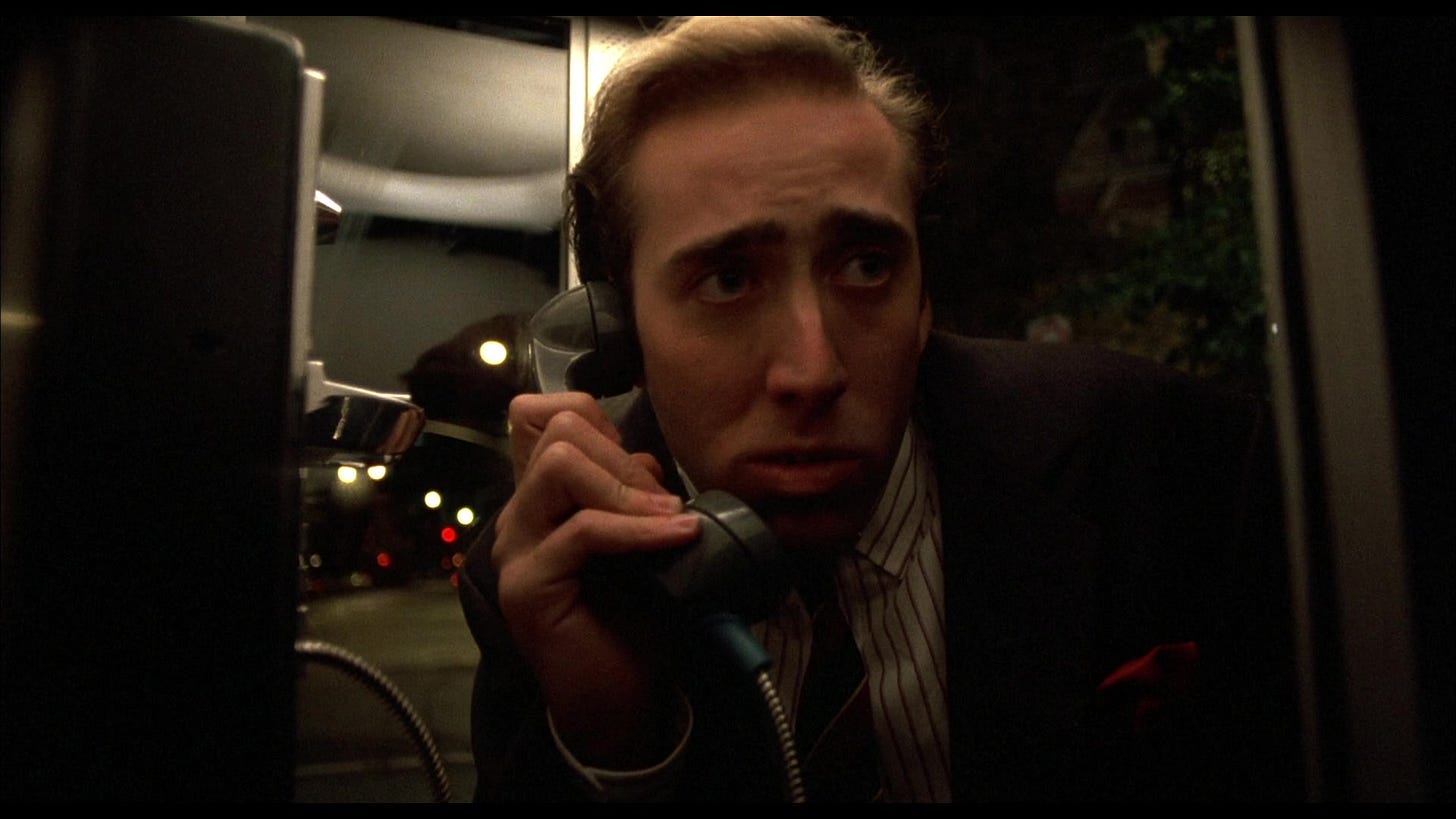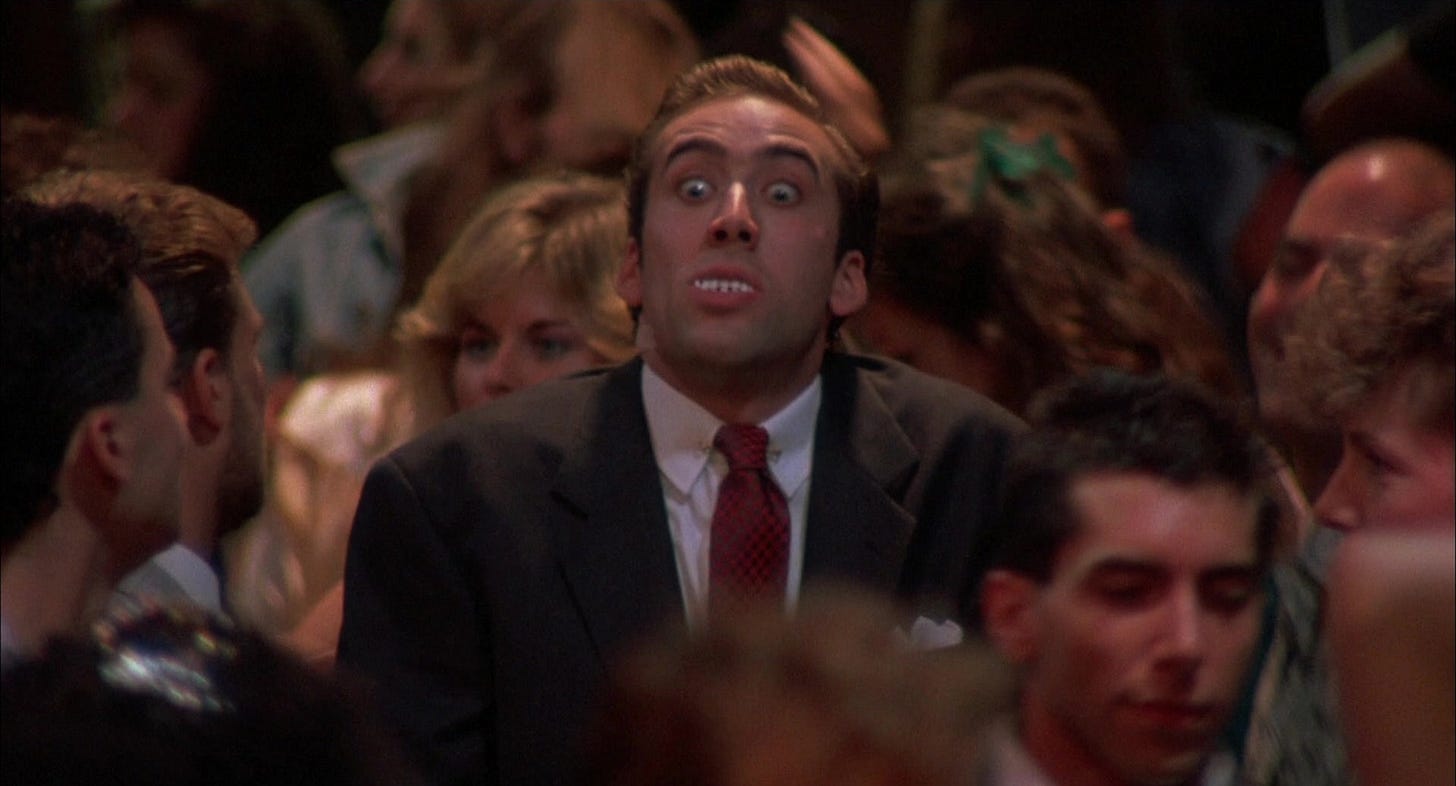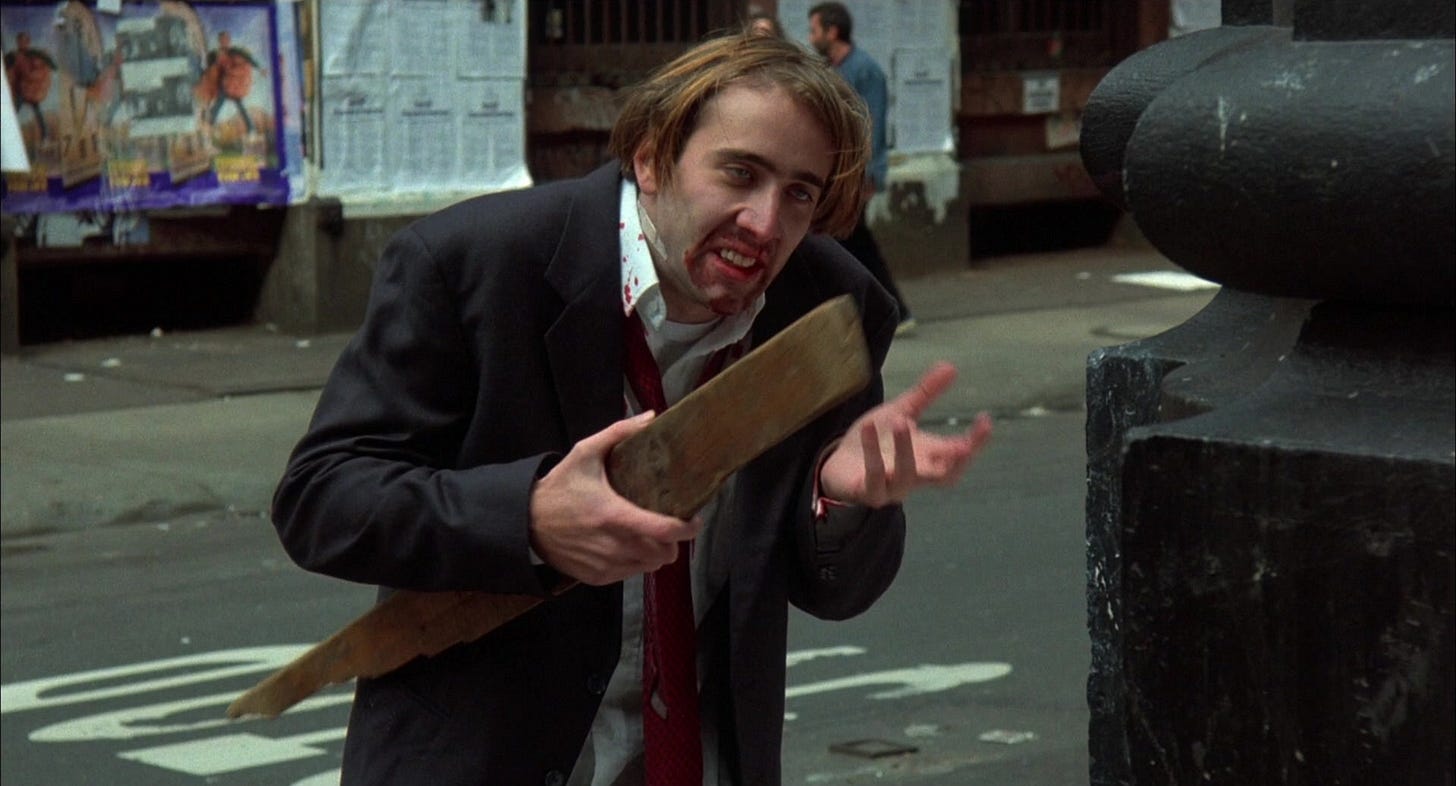In the month of October, Video Days is looking out for scaredy cats, counting down to All Hallows’ Eve with eight horror movies in ascending scariness.
VAMPIRE’S KISS (1989) is the equivalent of watching someone learn how to walk the tightrope at a circus that can’t afford a net. Every step feels like one too far is coming. Audacious, thrilling, rank amateurish in spots and impressively professional in others, its filmmakers had never made anything like this before, and regrettably, few of them would be given an opportunity to again. Small and imperfect, even the things this dark urban comedy gets wrong are more exciting than the things movies with better resources get right.
In January 1986, Joseph Minion had just won the movie lottery and was miserable. His NYU thesis screenplay A Night at Soho had been directed by Martin Scorsese as After Hours (1985). Though not a box office hit, Minion had received sole writing credit on a picture that had drawn a master filmmaker and prestigious cast. Roger Ebert had notched it #2 on his list of the year’s best films. Minion’s second screenplay Motorama–in which a 10-year-old boy steals a Ford Mustang on a quest to win a gas station promotion–called for a child actor to lead a film that wasn’t appropriate for children, the worst of two worlds. Nobody wanted to make it. By Minion’s account, he was also in a toxic relationship with his college girlfriend, Barbara Zitwer. Enamored by the Caribbean, she convinced Minion to take a vacation with her to Barbados, but once they arrived, his temperament compelled her to return to New York alone. In Zitwer’s version of events, she encouraged Minion to stay in Barbados to write a script set on the island, which she promised to produce. Minion rented a typewriter and spent two weeks exorcising his demons on paper. In his account, a guest at his hotel expressed a love for horror movies, and rather than a tropical script, Minion wrote his version of a horror movie.
Minion mailed his screenplay to Zitwer from Barbados. She was shocked by what she read, less because of what was on the page and more by what Minion implied about her. His main character, New York literary agent Peter Loew, falls apart due to a woman who–either real or imagined–has cursed him to become a vampire like her. Regardless, Zitwer and her producing partner Barry Shils would dedicate the next two years to getting Vampire’s Kiss produced. Shils had served as an associate producer on two pictures for New York-based exploitation filmmaker Larry Cohen–Special Effects (1984) and The Stuff (1985)--which is how he’d met Zitwer, a still photographer and location scout for Cohen. Another friend, Marcia Shulman–who’d worked as a casting agent on A Christmas Story (1983) and had been casting director for a big Fox movie shot in New York titled Turk 182 (1985)--came aboard as casting director and associate producer. Also working cheaply was Joseph Minion, attached to make his directorial debut from his screenplay. They managed to attach Dennis Quaid to play the lead, but with financing still up in the air, Quaid accepted an offer to star in a summer tentpole for Amblin Entertainment shooting that summer titled Innerspace (1987).
Word reached the filmmakers that Nicolas Cage was interested. Cage had made his leading man debut in the sleeper hit Valley Girl (1983) and established himself immediately as one of the most promising young actors in film, on a list with Matt Dillion, Sean Penn and Matthew Modine, all of whom Cage had worked with. He’d been the first bonafide star the Coen Brothers would work with, for their sophomore film Raising Arizona (1987), and was set to star opposite Cher in Moonstruck (1987). Minion met with Cage at a bar in the West Village and was impressed by the actor’s enthusiasm for his script. Cage saw Vampire’s Kiss as the story of a man whose search for love drives him insane, and the actor began a love affair with the material. The opposite held true for Minion, who’d broken up with Zitwer and needed distance from her. He dropped out as director. Zitwer and Shils found a replacement in Robert Bierman, director of a short film titled The Rocking Horse Winner (1983) that had served as his calling card to Hollywood. The town answered when Brooksfilm chose Bierman to direct their remake of The Fly. He’d worked with Charles Edward Pogue on rewrites and was preparing to shoot the horror film in his native England when his daughter was killed during a family vacation in South Africa. Bierman conceded he wasn’t in the frame of mind to work, and in 1986, had yet to line up his next job. Bierman chose to make Vampire’s Kiss his feature film debut.
With Cage on board, Zitwer and Shils had secured low budget financing from Hemdale Film Corporation. Co-founded by John Daly and actor David Hemmings as a talent agency based in London–they managed the rock bands Black Sabbath and Yes–Daly bought Hemmings out in 1971 and relocated the company to Los Angeles in 1980 to focus on motion picture financing. With his head of production Derek Gibson, Daly had raised the capital to produce progressively higher quality and more successful pictures: Cattle Annie and Little Britches (1980), Carbon Copy (1981), Yellowbeard (1983), The Terminator (1984), The Falcon and the Snowman (1985), Return of the Living Dead (1985), Salvador (1986), At Close Range (1986) and Hoosiers (1986). Hemdale helped raise the money for two back-to-back Academy Award winners for Best Picture–Platoon (1986) and The Last Emperor (1987)--though as an executive producer, Daly did not have an Oscar at home. John Daly and Derek Gibson came aboard Vampire’s Kiss as producers with Barbara Zitwer and Barry Shils. Moving ahead as the new director, Bierman met with Cage in Beverly Hills, but between the actor feeling he’d been misled that Minion would be directing, and his agent Ed Limato advising Cage that Vampire’s Kiss was not the sort of picture he should be taking himself off the market for, Cage exited the role.
Shils handed Steve Martin a copy of the script, which Martin’s agents did the dirty work of declining. Judd Nelson, who in 1986 some were betting on becoming a star, met with Bierman and wanted to play Peter Loew. His representation asked for $1 million, taking Nelson out of contention. On the other end of the pay scale was a New York actor named Adam Coleman Howard, who’d impressed everyone in his audition. Daly refused to finance the picture without a marketable lead actor. Zitwer and Shils heard through the grapevine that Nicolas Cage had some misgivings about letting Peter Loew slip through his fingers. The producers weren’t sure about going back to Cage or any actor who wasn’t as committed to Vampire’s Kiss as they were. They shared their dilemma with Larry Cohen, who told his protégés to put their pride aside and reach out to Cage about coming back. He did, though Cage’s deal took nearly a year to close, his representation exploring every avenue to steer their client toward a large paycheck (Cage would use all or most of the $40,000 he was paid for Vampire’s Kiss to buy his first sports car, a 1967 Chevrolet Corvette 427, overpaying for it, but as of 1999, still owner of the vintage Stingray).
Much of the crew were cutting their teeth with Vampire’s Kiss, which to reduce costs, came together as a non-union shoot (according to Bierman, their activity came to the attention of the Teamsters, who used bullhorns in an attempt to disrupt filming). Director of photography Stefan Czapsky had worked for Larry Cohen on Q: The Winged Serpent (1982) and Martin Scorsese on After Hours as a gaffer, but the most experience he’d had as a cinematographer was on a yet-to-be-released Errol Morris documentary titled The Thin Blue Line (1987). Editor Angus Newton had worked mostly in British television, graduating to features with Dreamchild (1985), a blend of fantasy and biography starring Ian Holm as author Lewis Carroll. Composer Colin Towns had scored Bierman’s short films–The Dumb Waiter (1979) and The Rocking Horse Winner–going to impressive lengths to make them sound like features. To stretch their budget, his score would be recorded in Romania with the Budapest Opera Orchestra. The filmmakers had entertained the notion of casting the same actor to play both Alva and Rachel, Peter Loew’s tormented assistant and the mystery woman who torments him, before settling on Maria Conchita Alonso for the former.
According to Bierman, he then cast an up-and-coming actor as Rachel, but on the Friday before filming, she begged off the picture after her fiancé objected to her playing intimate scenes with Cage. The actor had petitioned for Bierman to cast his girlfriend Patricia Arquette–who’d played the Final Girl in A Nightmare on Elm Street 3: Dream Warriors (1987)--as the vampire, but the director demurred. He offered the role to Jennifer Beals, who’d been a student at Yale when she was plucked out of obscurity to star in the blockbuster Flashdance (1983). Beals had since turned down several film offers, including the lead in Pretty In Pink (1986), to finish school and marry. For very little money and even less time to prepare for Vampire’s Kiss, she accepted the role on a Friday and was on the set on Tuesday. Bierman flirted with casting Jennifer Jason Leigh as Jackie, the young woman who Peter is romantically involved with, but Leigh (5’2”) didn’t look right standing next to Cage (6’0”). Kasi Lemmons (5’9”) was cast. Filling the last major role as Peter’s therapist was Elizabeth Ashley, whose husky Gulf Coast voice had been the class of stage, screen and television for thirty years.
Vampire’s Kiss commenced filming in August 1987 on a budget of roughly $2 million in New York. Locations were shot as they existed before Mayor Giuliani started cleaning up the town in the nineties. The bar where Peter picks up Jackie was the Mondo Cane Blues Bar in Greenwich Village, a major blues venue in Manhattan. Also paved into history is Munson Diner, the eatery in Hell’s Kitchen where Peter throws a tantrum. The occult bookshop where he shops for fangs was Magickal Childe in the Flatiron District, which closed its brick and mortar location in 1999 to move online. The disco where Peter goes cruising for a victim was The Tunnel, a nightclub in Chelsea. The scene where Peter wanders the streets at dawn carrying a stake were shot on the Lower East Side, where Czapsky set up a camera with a long focal lens across the street and filmed Cage wandering by pedestrians who didn’t know a movie was being filmed or that the blood on his collar was fake. Cage was treated like any other New Yorker talking to himself: ignored. Other locations included Gramercy Park for the exterior of Peter’s brownstone and the New York Life Building as the outside of the “lair” where he works. Peter and Jackie’s date was shot inside the New Museum of Contemporary Art, and his therapist’s office on the upper floor of a building overlooking Madison Square Park.
Despite never having directed an actor of Nicolas Cage’s caliber or anything close to it, Bierman worked closely with his leading man. He felt it appropriate for Loew’s madness to be turned up gradually as the film progressed. The director vetoed a pencil mustache that Cage showed up for work wearing, but did sign off on the accent the actor wanted to use, a faux British manner of speaking Cage had taken from his father August Coppola, then Dean of Creative Arts at San Francisco State University. Barbara Zitwer–whose impatience with Cage and his artistic temperament would also be turned up gradually as filming progressed–was livid over the accent, but Bierman argued that if Cage grounded his performance in reality–another Yuppie coming unglued–that character would be too despicable to tolerate. To their credit, Cage and Bierman would stick to Joseph Minion’s script except for one key revision, and it was one for the history books. For a scene in which Loew goes on a rampage in his kitchen, as scripted, he was to wolf down a raw egg. Neither Cage or Bierman thought that was disgusting enough. Cage suggested the thing he dreaded most: a cockroach. Bierman dispatched propsmen to the boiler room to see what they could wrangle and this being New York, they returned with a box containing several cockroaches, each divided by tissue paper so their director could cast his favorite.
At the end of her rope with Cage’s antics, Zitwer realized that her director was going along on this one. Being a good producer, she got a doctor on the phone to inquire whether or not a man could get sick from digesting a live cockroach. The doctor told Zitwer no, but to have her actor swig some whiskey immediately after, presumably to kick start digestion. Bierman shot two takes, Cage crunching and quickly swallowing one cockroach per take. The actor downed some 100-proof vodka right after. According to Barry Shils, when he ultimately got a call from animal rights activists about this business, he maintained no cockroaches had been harmed during filming. Vampire’s Kiss was screened at the Cannes Film Festival in May 1988 in anticipation of Hemdale releasing it theatrically in late July. The financier had regularly partnered with Orion Pictures to distribute commercial fare like Hoosiers, or handled distribution themselves for films that were aligned with an arthouse sensibility, like Salvador. Hemdale struck a deal with TriStar Pictures to distribute seven pictures in their pipeline, including Criminal Law starring Gary Oldman and Kevin Bacon, the doomsday thriller Miracle Mile with Anthony Edwards and Mare Winningham, the sixties-set coming-of-age tale Shag starring Phoebe Cates, Bridget Fonda and Annabeth Gish, and Vampire’s Kiss. TriStar backed out of distributing any of them, leaving Hemdale with seven movies that had no release date.
Daly had aspirations for building Hemdale into what Miramax Films would soon become: a mini-major that not only acquired and distributed pictures, but financed and distributed their own. First out of the gate was their most commercial title, Criminal Law, which Hemdale opened in April 1989 in 1,166 theaters. It spent three weekends among the top ten grossing films in the U.S. The rest of Hemdale’s pipeline would not fare that well at the box office. Miracle Mile opened in May in 143 theaters. Hoping to duplicate the success of Dirty Dancing (1987), Hemdale got Shag into 850 theaters in July. Lost in the shuffle would be Vampire’s Kiss, which after spending almost a year in the vault, opened in early June 1989 in a paltry 29 theaters. Critical reaction was checkered. In her review for the New York Times, Caryn James found Nicolas Cage’s “hunch-backed, clench-jawed performance” ridiculous, her only amusement derived from imagining former Saturday Night Live cast member Martin Short’s geek Ed Grimley being bitten by a vampire and bouncing off the walls. Writing for L.A. Weekly, Elvis Mitchell admitted that the film “jams a stake into its own heart” but heralded Nicolas Cage as “a magnetic, resourceful presence” whose commitment was unlikely to be topped by another actor anytime soon.
Kevin Thomas of the Los Angeles Times was the most enamored: “Vampire’s Kiss is the kind of film that would self-destruct with a single false move. But in bringing Joseph Minion’s mine-strewn script to the screen, British director Robert Bierman, in his theatrical feature debut, and his protean star Nicolas Cage never falter. The result is a sleek, outrageous dark comedy that’s all the funnier for constantly teetering on the brink of sheer tastelessness and silliness.” The challenge for Hemdale was appealing to audiences who didn’t want to see a movie titled Vampire’s Kiss, or horror fans who did but saw nothing in it that looked scary. The film was ignored as loudly as one could be, its failure impacting those who made it especially hard. Robert Bierman would return to feature films once more, directing Richard E. Grant and Helena Bonham Carter in A Merry War (1997), working in British television for most of his career. Barbara Zitwer returned to the Larry Cohen carnival on his Hitchcockian thriller The Ambulance (1990) starring Eric Roberts, serving as an associate producer, but otherwise, she never produced again, founding a New York literary agency in 1995. Barry Shils got Minion’s screenplay for Motorama (1992) produced by directing it himself, with appearances by Drew Barrymore, Michael J. Pollard, Robert Picardo, Dick Miller, Jack Nance and Martha Quinn, but his film opened in even fewer theaters than Vampire’s Kiss. Joseph Minion, who between the release of After Hours and Vampire’s Kiss scripted “Mirror, Mirror,” the episode of NBC’s Amazing Stories directed by Martin Scorsese, found no buyers for his dark sensibility in the late eighties. Stefan Czapsky did, hired as the DP on pictures both big–lighting Edward Scissorhands (1990), Batman Returns (1992) and Ed Wood (1994) for Tim Burton and Matilda (1996) for Danny DeVito–and small, continuing his partnership with documentarian Errol Morris.
Vampire’s Kiss is darkly magnificent and lustily funny in a way that could only have been possible by mistake. That doesn’t take away from how wonderful a film it is. Neither the script by Joseph Minion nor Robert Bierman’s direction of it seem to know or want to know whether Peter Loew has been cursed by a vampire, or if he’s manufactured this affliction as a way to cope with his male inadequacies. Either take would’ve made the movie cleaner and easier to summarize, something the muddled middle the filmmakers operate in makes difficult, yet its griminess is part of what makes the movie compelling. Because the filmmakers don’t seem to know where they’re going, neither does the viewer. It’s so unlike anything else–horror, comedy, horror/ comedy–and would be until the release of American Psycho (2000). If Christian Bale operates between a volume of 3-7 in his portrayal of homicidal minded Patrick Bateman, Nicolas Cage uses the whole dial and locates an extra level few actors before him had tapped into since the silent era. Cage’s full-tilt performance as a Yuppie Nosferatu in Vampire’s Kiss exists on the other side of the mirror from Tom Cruise in the Mission: Impossible pictures. Both actors redefine what a film leading man can do and can be allowed to do, but while Cruise is working with a world class safety team and hundreds of millions of dollars on stunts that are rehearsed for months in advance and ably assisted by computers, Cage pushes against safety and good sense with no more than a Paul Smith suit and a first-time director.
According to Stefan Czapsky, the actor didn’t even have a trailer for Vampire’s Kiss, no money for one in their budget. Just watching Cage and the progression of his character into hysterical blindness is riveting. Peter Loew begins the film like a child who’s overstayed his welcome on Pleasure Island and is in danger of transforming into something permanently ridiculous and perhaps hideous. He is a phony, he has no friends or family, he can’t honor a commitment or be bothered to treat people with kindness. Loew has zero socially redeeming qualities and Cage makes the character immensely compelling. His self-hatred seeps out of his eyelids and goes looking for others to infect. The only person in Loew’s life who has to put up with his act is his dutiful assistant. Maria Conchita Alonso’s limitations registering on film were done no favors by the decade she was working, in which women were too often asked to function as decor alongside men, but Alonso probably comes closest to crafting a memorable character in Vampire’s Kiss, playing an underpaid worker being pushed into a corner. The scariest scenes in Vampire’s Kiss are those which portray how normalized toxic environments can become, on our streets, and in our offices, Loew’s peers even joke with him about his atrocious behavior. Nicolas Cage gives one of the greatest leading man performances of this era–eating a cockroach for his art, something Tom Cruise has shown no interest in–while the lighting by Stefan Czapsky and musical score by Colin Towns contribute to the feeling that a bigger, fuller and more exciting movie is unfolding before us.
Video rental category: Comedy
Special interest: Femme Fatale
Thanks to Zach Schonfeld for his tremendous article for The Ringer dated June 13, 2019, “Truly Batshit: The Secret History of ‘Vampire’s Kiss,’ The Craziest Nicolas Cage Movie of All Time” documenting much of the film’s production history that might’ve otherwise been lost to time


